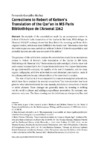Mostrar o rexistro simple do ítem
Corrections to Robert of Ketton’s Translation of the Qur’an in MS Paris Bibliothèque de l’Arsenal 1162
| dc.contributor.author | González-Muñoz, Fernando | |
| dc.date.accessioned | 2022-11-18T19:38:41Z | |
| dc.date.available | 2022-11-18T19:38:41Z | |
| dc.date.issued | 2021 | |
| dc.identifier.citation | González Muñoz, Fernando. "Corrections to Robert of Ketton’s Translation of the Qur’an in MS Paris Bibliothèque de l’Arsenal 1162", en: The Latin Qur'an, 1143-1500. Translation, Transition, Interpretation, ed. Cándida Ferrero Hernández and John Tolan. (Berlin:Walter de Gruyter, 2021), pp. 95-110 | es_ES |
| dc.identifier.isbn | 978-3110702637 | |
| dc.identifier.uri | http://hdl.handle.net/2183/32084 | |
| dc.description.abstract | [Abstract] An analysis of the emendations made by an anonymous reviser to Robert of Ketton’s Latin translation of the Qur’an in Ms Paris, Bibliothèque de l’Arsenal 1162 (12th century) shows that they distort the meaning and form of the original version, which was more faithful to the Arabic text. This makes clear that the revision process was carried out without Robert of Ketton’s supervision and probably by someone who was not part of his milieu. The purpose of this article is to analyze the emendations made by an anonymous reviser to Robert of Ketton’s Latin translation of the Qur’an in MS Paris, Bibliothèque de l’Arsenal 1162.2 As is commonly acknowledged, A is the most valuable extant manuscript in the Corpus Islamolatinum or the Corpus Cluniacense. Its age (mid-twelfth century), the quality of the text it transmits, and its clear, regular calligraphy, with few abbreviations and abundant punctuation, make it the primary witness for any critical edition of the texts that it contains. The text of Qur’an in A is accompanied by numerous marginal annotations, which have been analyzed by several researchers,3 but less attention has been given to other interventions in the text: namely, deletions or corrections of words or entire phrases. These changes are generally made by crossing or striking out the word or phrase and adding a superlinear annotation. By contrast, erasures are very rare. The lines crossing out the deletions are always very fine and thus the original text can easily be made out. In this study, we will examine a selection, first of suppressed words and passages, then of corrected passages. This examination will allow us to draw some conclusions about the reason behind these interventions, the identity of the corrector or correctors and the position of A in the stemma codicum of the Corpus Islamolatinum. Before setting forth specific examples, I should point out that the deletions and corrections in A were incorporated into the other 23 extant manuscripts of the Alchoran,4 as well as the two editions by Theodor Bibliander.5 In other words, all of the manuscripts and editions have only the corrected forms, never the original ones. This clearly demonstrates that A went through a revision process at a very early date and that the resulting new recension can be understood as the archetype of the Alchoran and the rest of the texts in the Corpus. | es_ES |
| dc.description.sponsorship | Ministerio de Ciencia, Innovación y Universidades ; PGC2018-093472-B-C31 | es_ES |
| dc.language.iso | eng | es_ES |
| dc.publisher | Walter de Gruyter | es_ES |
| dc.subject | Robert of Ketton | es_ES |
| dc.subject | Qur’an | es_ES |
| dc.subject | Arabic translations | es_ES |
| dc.subject | Transmission of texts | es_ES |
| dc.subject | Corpus Islamolatinum | es_ES |
| dc.subject | Corpus Cluniacense | es_ES |
| dc.subject | Corán | es_ES |
| dc.subject | Traducciones árabes | es_ES |
| dc.subject | Transmisión de textos | es_ES |
| dc.title | Corrections to Robert of Ketton’s Translation of the Qur’an in MS Paris Bibliothèque de l’Arsenal 1162 | es_ES |
| dc.type | info:eu-repo/semantics/bookPart | es_ES |
| dc.rights.access | info:eu-repo/semantics/openAccess | es_ES |
| UDC.startPage | 95 | es_ES |
| UDC.endPage | 110 | es_ES |






